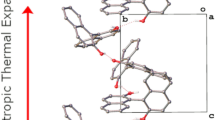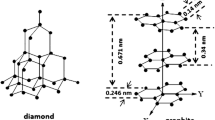Abstract
When a special preparation procedure has been applied, the crystallization system of boric acid has been changed from triclinic to hexagonal: at temperatures between 60 and 70 °C, under controlled pH conditions, the boric acid belonging to triclinic system was mixed with d-glucose, calcium carbonate, and calcium hydroxide. Thermal analysis evidenced a final compound with quite similar thermal behavior as that of initial triclinic boric acid but having some differences in decomposition kinetics. X-ray diffraction analysis showed a new compound, named HBA, belonging to the hexagonal crystallization system with the following lattice parameters: a = b = 20.4869 Å and c = 12.1506 Å. This strong anisotropic structure was also confirmed by the hexagonal form of the crystallites, grown from HBA and water solutions, which have been observed with a light polarized optical microscope. Exotic polycrystalline conglomerates grown from water solution of HBA have nice colours that are changing when they are set different angles between polarizer and analyser. FTIR measurements revealed the IR absorbance bands belonging to O–H, O–B, and H–O–B bonds of the trigonal planar boric acid, for both crystallographic systems, but some small differences between wave-numbers and peak intensities were encountered. Finally, the dielectric properties of the water solutions of HBA are analyzed by performing electric susceptibility measurements at different temperatures, from 25 to 50 °C.













Similar content being viewed by others
References
Jolly WL. Modern inorganic chemistry. 2nd ed. New York: McGraw-Hill; 1991.
Iavazzo C, Gkegkes ID, Zarkada IM, Falagas ME. Boric acid for recurrent vulvovaginal candidiasis: the clinical evidence. J Womens Health. 2011;20:1245–55.
Housecroft CE, Sharpe AG. Inorganic chemistry. 2nd ed. München: Pearson Prentice-Hall; 2005.
Perelygin YuP, Chistyakov DYu. Boric acid. Russ J Appl Chem. 2006;79:2041–2.
Rotaru P, Scorei R, Hărăbor A, Dumitru MD. Thermal analysis of a calcium fructoborate sample. Thermochim Acta. 2010;506:8–13.
Scorei RI, Rotaru P. Calcium fructoborate—Potential anti-inflammatory agent. Biol Trace Elem Res. 2011;143:1223–38.
Zachariasen WH. The precise structure of orthoboric acid. Acta Cryst. 1954;7:305–10.
Zapol P, Curtiss L, Erdemir A. Periodic ab initio calculations of orthoboric acid. J Chem Phys. 2000;113:3338–43.
Cullity B. Elements of X-ray diffraction. Reading: Addison-Wesley; 1978.
Pop V, Chicinas I, Jumate N. Material physics. Experimental methods. Cluj-Napoca: Presa Universitara Clujeana House; 2001.
Patterson AI. The Scherrer formula for X-ray particle size determination. Phys Rev. 1939;56:978–82.
Moanţă A, Ionescu C, Rotaru P, Socaciu M, Harabor A. Structural characterization, thermal investigation, and liquid crystalline behavior of 4-[(4-chlorobenzyl)oxy]-3,4′-dichloroazobenzene. J Therm Anal Calorim. 2010;102:1079–86.
Harabor A, Rotaru P, Harabor NA. Thermal and spectral behavior of (Y, Eu)VO4 powder. J Therm Anal Calorim. 2013;111:1211–9.
Pascu CI, Gingu O, Rotaru P, Vida-Simiti I, Harabor A, Lupu N. Bulk titanium for structural and biomedical applications obtaining by spark plasma sintering (SPS) from titanium hydride powder. J Therm Anal Calorim. 2013;113:849–57.
Rotaru A. Thermal analysis and kinetic study of Petrosani bituminous coal from Romania in comparison with a sample of Ural bituminous coal. J Therm Anal Calorim. 2012;110:1283–91.
Samide A, Tutunaru B, Negrilă C, Dobriţescu A. Study of the corrosion products formed on carbon steel surface in hydrochloric acid solution. J Therm Anal Calorim. 2012;110:145–52.
Rotaru A, Moanta A, Sălăgeanu I, Budrugeac P, Segal E. Thermal decomposition kinetics of some aromatic azomonoethers. Part I. Decomposition of 4-[(4-chlorobenzyl)oxy]-4′-nitro-azobenzene. J Therm Anal Calorim. 2007;87:395–400.
Donato DI, Lazzara G, Milioto S. Thermogravimetric analysis. A tool to evaluate the ability of mixtures in consolidating waterlogged archaeological woods. J Therm Anal Calorim. 2010;101:1085–91.
Rotaru A, Goşa M, Rotaru P. Computational thermal and kinetic analysis. Software for non-isothermal kinetics by standard procedure. J Therm Anal Calorim. 2008;94:367–71.
Rotaru A, Goşa M. Computational thermal and kinetic analysis. Complete standard procedure to evaluate the kinetic triplet form non-isothermal data. J Therm Anal Calorim. 2009;97:421–6.
Badea M, Olar R, Marinescu D, Segal E, Rotaru A. Thermal stability of some new complexes bearing ligands with polymerizable groups. J Therm Anal Calorim. 2007;88:317–21.
Rotaru A, Bratulescu G, Rotaru P. Thermal analysis of azoic dyes: part I. Non-isothermal decomposition kinetics of [4-(4-chlorobenzyloxy)-3-methylphenyl](p-tolyl)diazene in dynamic air atmosphere. Thermochim Acta. 2009;489:63–9.
Degeratu S, Rotaru P, Manolea Gh, Manolea HO, Rotaru A. Thermal characteristics of Ni–Ti SMA (shape memory alloy) actuators. J Therm Anal Calorim. 2009;97:695–700.
Peak D, Luther GW III, Sparks DL. ATR-FTIR spectroscopic studies of boric acid adsorption on hydrous ferric oxide. Geochim Cosmochim Acta. 2003;67:2551–60.
Feynman RP, Leighton RB, Sands M. The Feynman lectures on physics, vol. 2. Massachusetts: Addison-Wesley Reading; 1964.
Jackson JD. Classical Electrodynamics. New York-London-Sydney-Toronto: Wiley; 1975.
Kasap S. Dielectric materials: static relative permittivity. Saskatchewan: Mcgraw–Hill; 2006.
Spanulescu I. Electricity and magnetism. Bucharest: Victor Publisher; 2001.
Tanaka M, Sato M. Microwave heating of water, ice and saline solution: molecular dynamics study. J Chem Phys. 2007;126:034509.
Harabor A. Temperature effects on the electric susceptibility for a solution made from 10 mg of NaCl and 1 ml of H2O. Phys AUC. 2006;16:68–73.
Author information
Authors and Affiliations
Corresponding author
Rights and permissions
About this article
Cite this article
Harabor, A., Rotaru, P., Scorei, R.I. et al. Non-conventional hexagonal structure for boric acid. J Therm Anal Calorim 118, 1375–1384 (2014). https://doi.org/10.1007/s10973-014-4169-5
Received:
Accepted:
Published:
Issue Date:
DOI: https://doi.org/10.1007/s10973-014-4169-5




